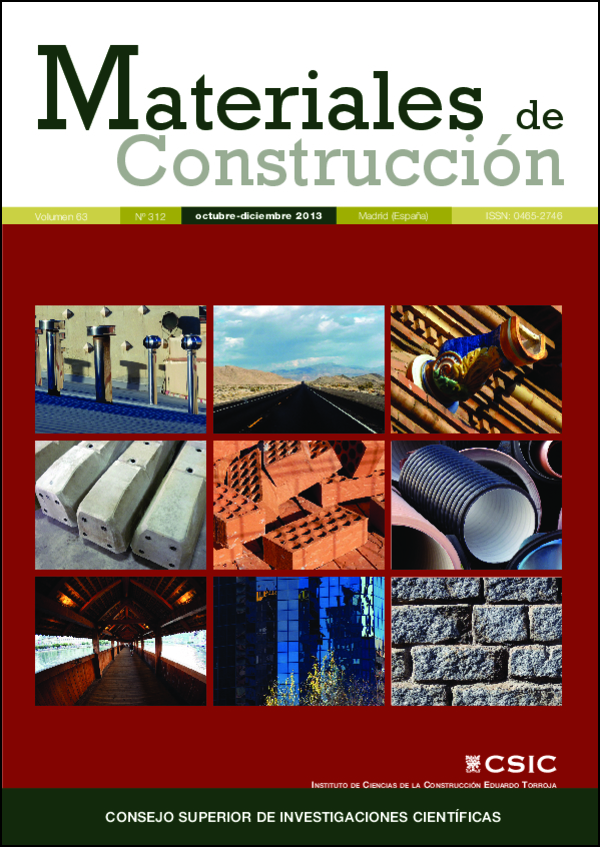Castle-palace of “La Calahorra”, Granada: influence of climatic and architectural factors in differential deterioration of their stone masonries
DOI:
https://doi.org/10.3989/mc.2013.04112Keywords:
Stone masonries, Differential deterioration, Environmental agents, Building defectsAbstract
The castle-palace of La Calahorra is a historical building (6th century ) with a dual-function. The exterior is a castle-fortress of late-medieval style, built with rubbles and rough ashlars of a crystalline limestone of great hardness and strength. The interior is a Renaissance palace, made of micritic limestone and dolomitic sandstone ashlars, both stone materials are porous, soft and low strength. The entire building has an orangey colored due to an iron patina that stains its stone masonries as a result of wind action. There is a differential deterioration among its external and internal, depending on the type of stone used factories, the rainwater and wind action and the building defects detected. While the exterior stone is in good state of conservation, the interior stones shows some important deterioration processes , mainly the micritic limestone present in the ornamental and decorative areas of the central courtyard.
Downloads
References
(1) Nieto-Alcaide, V.M., Checa-Cremades, F.: Arquitectura del Renacimiento en España 1488-1599. Madrid. (1989) y reeds.
(2) Henares-Cuellar, I., López Guzmán, R.: El Castillo-Palacio de la Calahorra. Alzada, COAAT Granada, vol. 72, (2004), pp. 52-68.
(3) Guardia-Olmedo, J.J., Varas-Muriel, M.J.: Studied the Natural and Artificial Materials used in the Construction of the Calahorra, Granada, Spain.I Congreso Internacional de Investigación en Edificación. Libro de Abstracts pp. 71. Madrid. (2009)
(4) Lindholm, R.C., Finkelman, R.B.: “Calcite staining: semiquantitative determination of ferrous iron”. Journal of Sedimentary Petrology, vol. 42, (1972), pp. 239- 242.
(5) Magna nº 1011 (Guadix): Mapa Geológico de España 1:50.000. 1ª Edición, 2ª Serie. IGME. Madrid. (1980).
(6) Vera, J.A.: “Estudio estratigráfico de la depresión de Guadix-Baza”. Bol. Geol. Min., vol. 81, (1970), pp. 429-462.
(7) Freytet, P., Plaziat J.: Continental carbonate sedimentation and pedogenesis. Contributions to sedimentology, 11. Schweizerbart-Verlagsbuch. 216 pp. (1982).
(8) Arribas, M.E., Fernández, J., García-Aguilar J.M.: “Análisis sedimentológico de los materiales lacustres (Formación de Gorafe-Huelago) del sector central de la depresión de Guadix”. Estudios Geol., vol. 44, (1988), pp. 61-73.
Downloads
Published
How to Cite
Issue
Section
License
Copyright (c) 2013 Consejo Superior de Investigaciones Científicas (CSIC)

This work is licensed under a Creative Commons Attribution 4.0 International License.
© CSIC. Manuscripts published in both the print and online versions of this journal are the property of the Consejo Superior de Investigaciones Científicas, and quoting this source is a requirement for any partial or full reproduction.
All contents of this electronic edition, except where otherwise noted, are distributed under a Creative Commons Attribution 4.0 International (CC BY 4.0) licence. You may read the basic information and the legal text of the licence. The indication of the CC BY 4.0 licence must be expressly stated in this way when necessary.
Self-archiving in repositories, personal webpages or similar, of any version other than the final version of the work produced by the publisher, is not allowed.
















